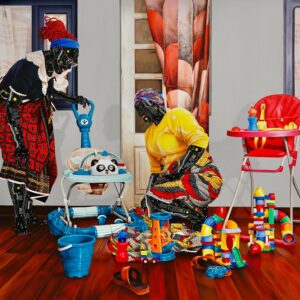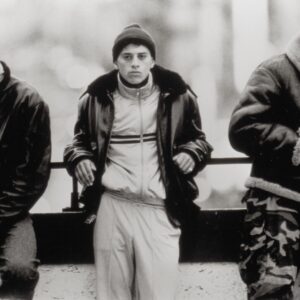
Damien Hirst, 2019 ©Damien Hirst and Science Ltd. All rights reserved, DACS 2019
“The Cherry Blossoms are about beauty and life and death. They’re extreme—there’s something almost
Damien Hirst
tacky about them. […] They’re decorative but taken from nature. […] They’re garish and messy and
fragile and about me moving away from Minimalism and the idea of an imaginary mechanical painter
and that’s so exciting for me.”
Cherry Blossoms is Damien Hirst’s first museum exhibition in France. The Cherry Blossoms series reinterprets, with playful irony, the traditional subject of landscape painting. Hirst combines thick brushstrokes and elements of gestural painting, referencing both Impressionism and Pointillism, as well as Action Painting. The monumental canvases, which are entirely covered in dense bright colours, envelope the viewer in a vast floral landscape moving between figuration and abstraction. The Cherry Blossoms are at once a subversion and homage to the great artistic movements of the late nineteenth and twentieth centuries. They are integral to the pictorial exploration long carried out by Hirst. In his London studio, the artist describes “diving into the paintings and completely blitzing them from one end to the other”.

Cherry Blossom (detail), 2019 ©Damien Hirst and Science Ltd. All rights reserved, DACS 2019
He also talks about working on several canvases at the same time and constantly returning to these, which he kept close by, months after their completion. After devoting three full years to the series, Damien Hirst
finished the Cherry Blossoms series in November 2020 :
“[The pandemic] has given me a lot more time to live with the paintings, and look at them, and make absolutely certain that everything’s finished.”
The complete series comprises 107 canvases (all reproduced in the exhibition catalogue), divided into single panels, diptychs, triptychs, quadriptychs, and even a hexaptych, all large-format. The exhibition, a response to an invitation by Hervé Chandès, General Director of the Fondation Cartier, to Damien Hirst during a meeting in London in 2019, presents thirty paintings selected by Hervé Chandës and the artist. Taking over the space designed by Jean Nouvel, the canvases, covered in thick, vibrant paint, absorb the spectator into the paintings.

Photograph by Prudence Cuming Associates. ©Damien Hirst and Science Ltd. All rights reserved, DACS 2019
After studying in Leeds, Damien Hirst entered Goldsmiths College in London in 1986 and quickly became the face of the Young British Artists, a group with a taste for experimentation and creating art viewed as provocative by some. They dominated the British arts scene in the 1990s. Hirst’s Natural History series — in which animals appear in formaldehyde filled tanks — soon became emblematic of his work. However, painting has always played an essential role in Hirst’s work:
“I’ve had a romance with painting all my life, even if I avoided it. As a young artist, you react to the context, your situation. In the 1980s, painting wasn’t really the way to go.”

Damien Hirst, Renewal Blossom, 2018. Photographed by Prudence Cuming Associates. ©Damien Hirst and Science Ltd. All rights reserved, DACS 2019
If his early canvases were inspired by Abstract Expressionism, which he refers to as a “paint how you feel” approach, in 1986 he began a series known as Spot Paintings, where coloured dots, which appear to have been painted by a machine, erase all traces of human intervention. Initially conceived as an ongoing series, today, the Spot Paintings include over one thousand canvases of varying sizes and titles. In contrast with the mathematical infinity of the Spot Paintings, the Visual Candy paintings (1993-1995), ironically named after a scathing comment by an art critic who said the paintings looked like curtain designs, are characterised by their thick smudges of paint and exuberant superimposed colours. More recently, the series known as Colour Space (2016), a variation around the infinite possibility of colour, and Veil Paintings (2018), where dabs of paint shimmer and cover the entire canvas, celebrate the painting surface,
depth and colour. This exploration culminates in the Cherry Blossoms.
“The Cherry Blossoms are about beauty and life and death. They’re extreme—there’s something almost tacky about them. Like Jackson Pollock twisted by love. They’re decorative but taken from nature.
Damien Hirst
They’re about desire and how we process the things around us and what we turn them into, but also about the insane visual transience of beauty—a tree in full crazy blossom against a clear sky. It’s been so good to
make them, to be completely lost in colour and in paint in my studio. They’re garish and messy and fragile and about me moving away from Minimalism and the idea of an imaginary mechanical painter and that’s so exciting for me.”
For the exhibition, several films were made in collaboration with Damien Hirst. A medium-length film, shot over several months, allows spectators to discover the ambience of the artist’s Thames-side studio. A second film, shot in 360°, allows viewers, guided by Damien Hirst’s voice, to explore another of his studios. Both films will be available to be watched online for the duration of the exhibition.
DAMIEN HIRST CHERRY BLOSSOMS 6th July 2021 – 2nd January 2022 at The Fondation Cartier pour l’art contemporain @fondationcartier
The Fondation Cartier pour l’art contemporain will publish a remarkable book containing all of the 107 paintings that make up the Cherry Blossoms series, including a multitude of details reproduced in life-size. This catalogue raisonné plunges the reader into this exceptional series, a veritable ode to painting and colour, to which Damien Hirst devoted the past three years. With contributions by philosopher Emanuele Coccia, art historians Philippe Costamagna, Michio Hayashi, Gilda Williams, and writer Alberto Manguel, the essays analyse the Cherry Blossoms’ place in the work of Damien Hirst, while exploring their artistic, philosophical and literary resonances. Damien Hirst, Cherry Blossoms Publisher: Fondation Cartier pour l’art contemporain, Paris Hardback, 26 × 36.5 cm, 330 pages – 250 colour reproductions ISBN: 978-2-86925-158-8 Retail Price: €60 – Publication date: May 2021
About the Artist
Born in Bristol (UK) in 1965, Damien Hirst grew up in Leeds before moving to London in 1984, where he still lives today. In 1988, while studying at Goldsmiths College, he organised the exhibition Freeze, presenting his
works alongside those of other students. The exhibition launched his career, as well as that of numerous other emerging artists and marked the genesis of the Young British Artists. In 1995, he was awarded the Turner Prize. Working across sculpture, installation, painting and drawing, Damien Hirst explores themes connected to life and death, excess and fragility. An internationally renowned artist, his work has been exhibited at the
Tate Modern in London as part of a large retrospective (Damien Hirst, 2012), at the Palazzo Grassi and Punta della Dogana in Venice (Treasures from the Wreck of the Unbelievable, 2017).







